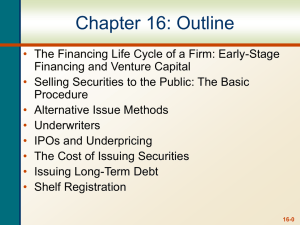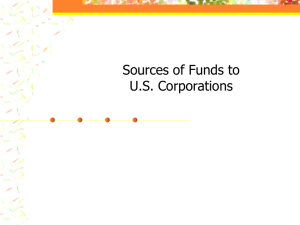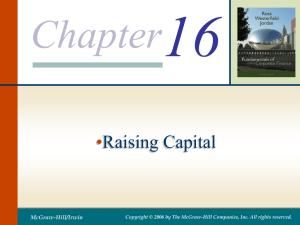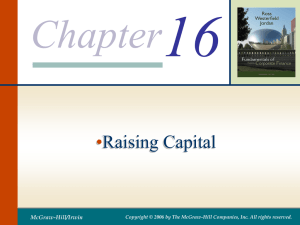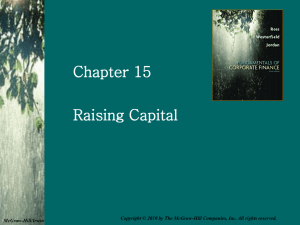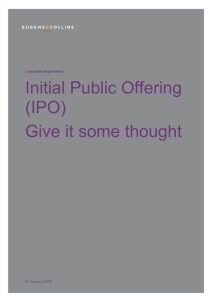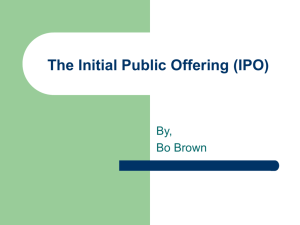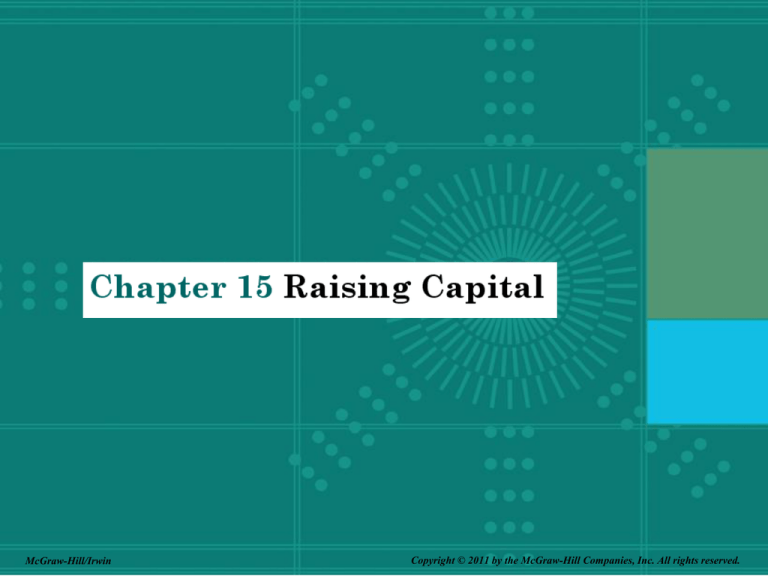
15-1
McGraw-Hill/Irwin
Copyright © 2011 by the McGraw-Hill Companies, Inc. All rights reserved.
Key Concepts and Skills
Understand:
• The venture capital market and its role in
financing new businesses
• How securities are sold to the public, and
the role of investment bankers
• Initial public offerings, and the costs of
going public
15-2
Chapter Outline
15.1 The Financing Life Cycle of a Firm: EarlyStage Financing and Venture Capital
15.2 Selling Securities to the Public: The Basic
Procedure
15.3 Alternative Issue Methods
15.4 Underwriters
15.5 IPOs and Underpricing
15.6 New Equity Sales and the Value of the
Firm
15.7 The Cost of Issuing Securities
15.8 Issuing Long-Term Debt
15.9 Shelf Registration
15-3
Venture Capital
“Private Equity”
• Private financing for new, high risk
businesses in exchange for stock
– Individual investors
– Venture capital firms
• Usually involves active participation by VC
• Ultimate goal: take company public; the VC
will benefit from the capital raised in the IPO
• Hard to find
• Expensive
Return to
Quick Quiz
15-4
Venture Capital Stage Financing
• Funding provided in several stages
• Contingent upon specified goals at each
stage
• First stage
– “Ground floor” or “Seed money”
– Fund prototype and manufacturing plan
• Second Stage
– “Mezzanine” financing
– Begin manufacturing, marketing & distribution
15-5
Choosing a Venture Capitalist
•
•
•
•
•
Financial strength
Compatible management style
Obtain and check references
Contacts
Exit strategy
15-6
Selling Securities to the Public
1. Management obtains permission
from the Board of Directors
2. Firm files a registration statement
with the SEC
3. SEC examines the registration during
a 20-day waiting period
4. Securities may not be sold during the
waiting period
15-7
Selling Securities to the Public
5. A preliminary prospectus, called a red
herring, is distributed during the waiting
period
- If problems, the company amends the
registration, and the waiting period starts
over
6. Price per share determined on the
effective date of the registration and the
selling effort begins
15-8
Issue Methods
• Public Issue
– Registration with SEC required
– General cash offer = offered to general public
– Rights offer = offered only to current
shareholders
– IPO = Initial Public Offering = Unseasoned new issue
– SEO = Seasoned Equity Offering
• Private Issue
– Sold to fewer than 35 investors
– SEC registration not required
15-9
Methods of Issuing New Securities
Table 15.1
15-10
Underwriters
• Underwriting services:
–
–
–
–
Formulate method to issue securities
Price the securities
Sell the securities
Price stabilization by lead underwriter in the
aftermarket
• Syndicate = group of investment bankers that
market the securities and share the risk
associated with selling the issue
• Spread = difference between what the
syndicate pays the company and what the
security sells for in the market
Return to
Quick Quiz
15-11
Tombstone
Figure 15.1
• Investment banks in
syndicate divided
into brackets
•Firms listed alphabetically
within each bracket
•“Pecking order”
•Higher bracket =
greater prestige
•Underwriting success
built on reputation
15-12
Firm Commitment Underwriting
• Issuer sells entire issue to underwriting syndicate
• Syndicate resells issue to the public
• Underwriter makes money on the spread
between the price paid to the issuer and the
price received from investors when the stock is
sold
• Syndicate bears the risk of not being able to sell
the entire issue for more than the cost
• Most common type of underwriting in the United
States
Return to
Quick Quiz
15-13
Best Efforts Underwriting
• Underwriter makes “best effort” to sell the
securities at an agreed-upon offering price
• Issuing company bears the risk of the issue not
being sold
• Offer may be pulled if not enough interest at the
offer price
– Company does not get the capital and they have still
incurred substantial flotation costs
• Not as common as it used to be
15-14
Dutch or Uniform Price Auction
Buyers:
•Bid a price and number of shares
Seller:
•Work down the list of bidders
•Determine the highest price at which they
can sell the desired number of shares
•All successful bidders pay the same price
per share.
•Encourages aggressive bidding
15-15
Dutch or Uniform Price Auction
Example
The company wants to sell 1,500 shares of stock.
Bidder
A
B
C
D
E
Quantity
500
400
250
350
200
Bid
$20
18
16
15
12
The firm will sell 1,500 shares at $15 per share.
Bidders A, B, C, and D will get shares.
Bidder
A
B
C
D
E
Quantity
500
400
250
350
200
Bid
$20
18
16
15
12
Σ Qty
500
900
1,150
1,500
1,700
15-16
Green Shoe Provision
• “Overallotment Option”
• Allows syndicate to purchase an additional
15% of the issue from the issuer
• Allows the issue to be oversubscribed
• Provides some protection for the lead
underwriter as they perform their price
stabilization function
• In all IPO and SEO offerings but not in
ordinary debt offerings
15-17
Lockup Agreements
• Not legally required but common
• Restricts insiders from selling IPO
shares for a specified time period
– Common lockup period = 180 days
• Stock price tends to drop when the
lockup period expires due to market
anticipation of additional shares hitting
the Street
15-18
IPO Underpricing
• IPO pricing = very difficult
– No current market price available
• Dutch Auctions designed to
eliminate first day IPO price “pop”
• Underpricing causes the issuer to
“leave money on the table”
• Degree of underpricing varies over
time
Return to
Quick Quiz
15-19
IPO Underpricing Reasons
• Underwriters want offerings to sell out
– Reputation for successful IPOs is critical
– Underpricing = insurance for underwriters
– Oversubscription & allotment
– “Winner’s Curse”
• Smaller, riskier IPOs underprice to attract
investors
Return to
Quick Quiz
15-20
Example: Work the Web
• How have recent IPOs performed?
• Click on the Web surfer to go to
Hoovers.com’s “IPO Central”
– Use the “IPO Calendar” to determine how
many companies went public during the last
week
– Use “IPO Performance” to determine how
companies that went public three months
ago have performed. What about six
months ago?
15-21
Seasoned Equity Offerings
• Stock prices tend to decline when new equity is
issued
• Signaling explanations:
– Equity overvalued: If management believes equity is
overvalued, they would choose to issue stock shares
– Debt usage: Issuing stock may indicate firm has too
much debt and can not issue more debt
• Issue costs
– Issue costs for equity – direct and indirect are significantly more than for debt
15-22
The Cost of Issuing Securities
INSERT TABLE FROM PAGE 486
(middle of the page)
Return to
Quick Quiz
15-23
The Cost of Issuing Securities
• Total direct costs ≈ 10.4%
– Direct costs very large, especially for issues
< $10 million (25.22%)
• Underpricing cost ≈ 19.3%
• Average spread = 7%
• Patterns:
– Substantial economies of scale
– Costs of selling debt < issuing equity
– IPO costs > SEO costs
– Straight bonds < Convertible bonds
15-24
Types of Long-term Debt
• Bonds – public issue of long-term debt
• Private issues
– Term loans
• Direct business loans from commercial banks,
insurance companies, etc.
• Maturities 1 – 5 years
• Repayable during the life of the loan
– Private placements
• Similar to term loans with longer maturity
– Easier to renegotiate than public issues
– Lower costs than public issues
• No SEC registration
Return to
Quick Quiz
15-25
Shelf Registration
• SEC Rule 415
• Permits firm to register a large issue
with the SEC and sell it in small portions
• Reduces flotation costs
• Allows company more flexibility to raise
money quickly
Return to
Quick Quiz
15-26
Shelf Registration
• Requirements
– Company must be rated investment
grade
– Cannot have defaulted on debt within
last three years
– Market value of stock must be greater
than $150 million
– No violations of the Securities Act of
1934 in the preceding three years
Return to
Quick Quiz
15-27
Quick Quiz
1. What is venture capital and what
types of firms receive it? (Slide 15.4)
2. What are some of the important
services provided by underwriters?
(Slide 15.11)
3. What type of underwriting is the
most common in the United States
and how does it work? (Slide 15.13)
15-28
Quick Quiz
4. What is IPO underpricing and why
might it persist? (Slide 15.19 and 15.20)
5. What are some of the costs
associated with issuing securities?
(Slide 15.23)
6. What are some of the characteristics
of private placement debt? (Slide 15.25)
7. What is shelf registration? (Slide 15.26)
15-29
Chapter 15
END

